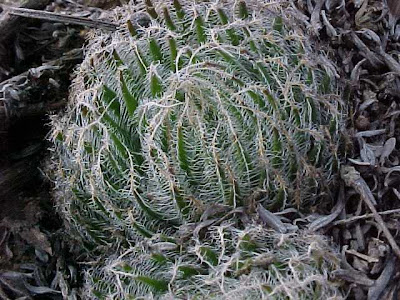Haworthia aranea is closely related to Haworthia arachnoidea, but differs from the latter mainly in the multiple small soft hairs on the leaf margins and keel. Haworthia arachnoidea fewer and shorter hairs, and is normally a more robust plant.
Plants growing protected under Euphorbia enopla.
The three images above are from Vergelegen where the plants grow in Enon conglomerate.
The plants are attractive and prefer shady south facing cliffs on mountain slopes and hillsides although some populations on north facing cliffs also exist. The natural distribution of Haworthia aranea is mainly between Oudtshoorn and Uniondale. Some populations around Ladismith are similar however making a clear distinction between species difficult.
East of De Rust some similar looking plant have translucent leaf tips e.g. Haworthia erii .
Haworthia aranea is not difficult to cultivate, but the plants hate to remain wet at the base for an extended period. Propagation is from seed.
 Haworthia aranea in habitat at Matjiesvlei east of Oudtshoorn.
Haworthia aranea in habitat at Matjiesvlei east of Oudtshoorn.Synonym" Haworthia arachnoidea 'aranea' (Sensu M.B. Bayer)." We are now mostly adopting the approach by Ingo Breuer as set out in "The Genus Haworthia" for the sake of communication on the genus as this seems a more usable approach.




Post a Comment